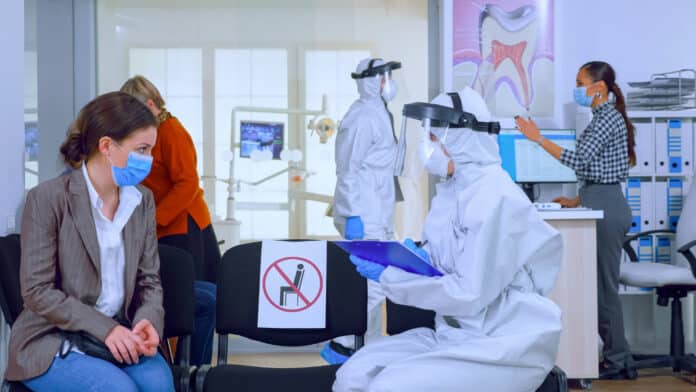A new study from Northwestern Medicine at Northwestern University found that COVID patients release much of the virus in their breath during the first eight days after showing symptoms. This can be as much as 1,000 copies of the virus per minute.
This study is the first to directly measure how many copies of the SARS-CoV-2 virus people breathe out each minute during their infection, from the beginning of symptoms until 20 days later.
On the eighth day, the amount of virus in their breath drops significantly, down to nearly the most minuscule amount we can measure – about two copies per minute.
The researchers at Northwestern tested the breath of 44 people several times a day throughout their illness to figure out when they were most likely to spread the virus to others.
The study will be published in a journal called eLife, and it has also been made available online before it’s officially published.
People with mild and moderate COVID-19 symptoms release much of the virus when they breathe. Even those with severe symptoms remove even more virus, according to the study. The study found that vaccinated and unvaccinated people release about the same amount of virus during their infection.
Senior author Christina Zelano, assistant professor of neurology at Northwestern University Feinberg School of Medicine, said, “An important question in understanding the transmission of SARS-CoV-2 is how much virus a patient is exhaling into the environment over the course of their infection and for how long. During COVID-19 infection, at what point are you exhaling much virus, and when do you stop breathing it out?”
The majority of COVID-19 research has focused on using swabs from the nose or throat to measure the virus,” said Gregory Lane, who led the study. “But the virus spreads through breath, and what’s in your breath might not be the same as what’s in your nose. We don’t understand how the virus in breath changes during the infection, even though this is how it spreads.”
Researchers also didn’t know how the amount of viral RNA in breath relates to how sick someone gets, whether they are vaccinated, their type of virus, and their age and gender. The team needed a way to directly measure viral RNA in breath over time in the same person to find out.
“We created a simple and inexpensive method to do this and collected over 300 breath samples from 44 COVID patients throughout their infections, taking multiple samples each day for several days,” Lane explained.
Using this new method, they found they could detect viral RNA in every sample from COVID-19-positive patients in the first ten days of their symptoms. They couldn’t find any in samples from people who didn’t have COVID-19. This means the method was very accurate.
The study’s findings can help determine how long someone can release enough SARS-CoV-2 virus to infect others.
If 300 virus copies can infect someone, exhaling 1,000 documents per minute could potentially infect someone in just 20 seconds (like in a crowded elevator, which is risky). Conversely, exhaling only two copies per minute would take around two hours to release enough to infect someone (likely safe in an elevator).
However, we’re still determining the exact number of viral particles needed to infect someone through the air.
To conduct the study, Northwestern researchers created an affordable device for collecting breath samples from COVID-19-infected individuals without invasive procedures. They used qPCR to detect the virus in these samples while patients breathed for 10 minutes. This helped establish a baseline for the typical amount of virus exhaled. If patients talked, sang, or shouted, they might release even more virus.
These researchers then sent the device to patients’ homes, where patients learned how to collect their breath samples by watching an online video. These patients, who were getting tested for COVID-19 at Northwestern Medicine, provided multiple breath samples daily during their infection.
The collected samples were returned to the lab, where qPCR was used to count how many copies of the virus’s RNA were in each breath sample.
Knowing how many viruses someone breathes out each day after they get sick helps us understand how COVID-19 spreads. It helps us figure out when someone with COVID-19 should stay away from others, when they’re most likely to spread the virus by breathing it into the air, and when they’re less likely to extend it. This information is crucial for controlling the infection and making public health recommendations.
The study found that from the first day of symptoms (day zero) until day eight, people with COVID-19 breathed out much virus. The amount varied, but on average, it was high. Then, on day eight, it dropped significantly and stayed low, with just a few exceptions.
The device used in the study can be made by following the instructions in the paper, and it can also be used to measure pathogens in the breath for other respiratory diseases.
Journal Reference:
- Gregory Lane, Guangyu Zhou, et al., Quantity of SARS-CoV-2 RNA copies exhaled per minute during natural breathing over the course of COVID-19 infection. eLife. DOI: 10.1101/2023.09.06.23295138.
